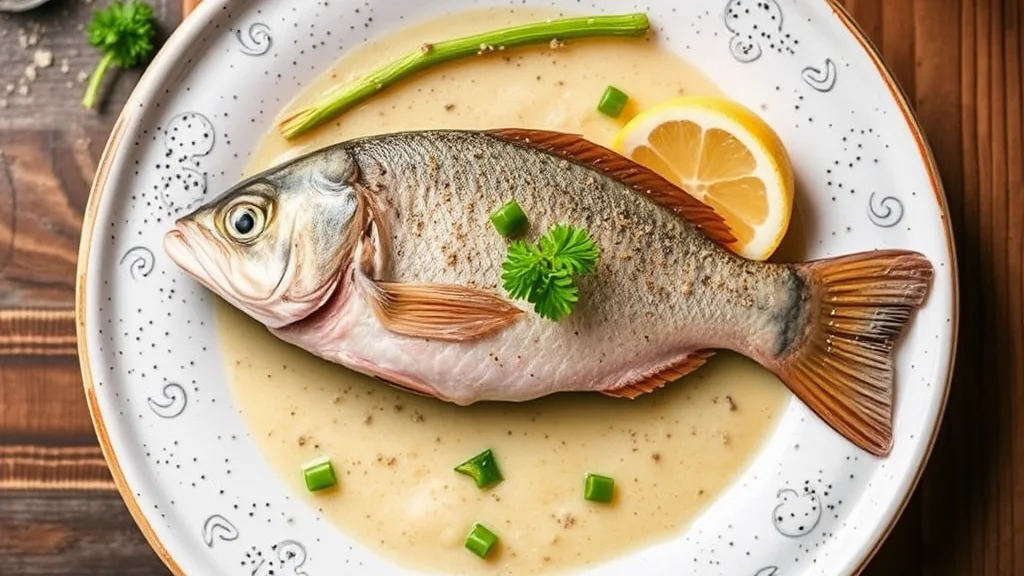Fish: A Nutrient-Packed Superfood for Every Meal
Key Takeaways:
- Fish is an excellent source of high-quality protein and essential nutrients like omega-3 fatty acids.
- Regular consumption of fish helps promote heart, brain, and joint health.
- Both lean and fatty fish varieties offer unique health benefits and can be incorporated into various cooking methods.

Nutritional Profile of Fish
Fish provides a wide range of nutrients essential for overall health. Below is a typical nutritional breakdown for 100 grams of cooked fish (e.g., salmon):
| Nutrient | Amount |
|---|---|
| Calories | 206 kcal |
| Protein | 22 grams |
| Fat | 13 grams |
| Omega-3 Fatty Acids | 1.8 grams |
| Vitamin D | 526 IU (132% DV) |
| Selenium | 36.5 mcg (66% DV) |
Omega-3 Fatty Acids in Fish
One of the key reasons fish is a superfood is due to its high levels of omega-3 fatty acids. These fats are crucial for reducing inflammation, promoting brain function, and supporting heart health.
Health Benefits of Eating Fish
Eating fish regularly can provide numerous health benefits, which are backed by scientific studies:
1. Cardiovascular Health
Omega-3 fatty acids found in fatty fish like salmon, sardines, and mackerel are known to reduce blood pressure, decrease the risk of heart disease, and lower triglyceride levels.
2. Brain Function and Cognitive Health
Fish consumption, particularly of fatty fish, has been associated with improved cognitive performance and a reduced risk of cognitive decline. The omega-3 fatty acid DHA supports brain function and may prevent neurodegenerative conditions like Alzheimer’s disease.
3. Rich in Protein
Fish is a lean source of high-quality protein, containing all essential amino acids. Protein from fish aids in muscle growth, tissue repair, and immune health, making it an excellent choice for people across all ages.
Popular Types of Fish and Their Benefits
Fish are generally categorized into fatty and lean varieties, both offering different nutritional benefits. Here’s an overview of some popular fish types:
| Fish Type | Characteristics | Best Cooking Methods |
|---|---|---|
| Salmon | Fatty, rich in omega-3s, bold flavor | Grilling, baking, poaching |
| Tuna | Meaty texture, rich in protein | Seared, grilled, canned |
| Cod | Mild, flaky, lean, low in fat | Baking, frying, broiling |
| Mackerel | Oily, strong flavor, high in omega-3s | Smoking, grilling, pan-frying |
| Tilapia | Mild flavor, low in fat, affordable | Baking, sautéing, grilling |
Cooking Methods for Fish
Fish is a versatile ingredient that can be cooked in many ways. Here are some common methods:
1. Baking
Baking is a healthy way to cook fish, especially for lean varieties like cod or haddock. Season your fish with herbs, a dash of olive oil, and bake at 350°F for 12-15 minutes, or until the fish flakes easily.
2. Grilling
Grilling is perfect for firmer fish like salmon and tuna. It gives the fish a delicious smoky flavor and crispy texture. For best results, oil the grill grates and cook for a few minutes on each side.
3. Poaching
Poaching fish in broth or water preserves its delicate texture. This method works well with softer fish like halibut or tilapia and ensures the fish remains moist.
Is Eating Fish Safe? Considerations on Mercury and Sustainability
While fish is an excellent source of nutrition, there are a few safety considerations:
Mercury Levels in Fish
Certain fish, such as swordfish, king mackerel, and tilefish, contain higher levels of mercury, a heavy metal that can be harmful when consumed in large amounts. To minimize mercury exposure, opt for low-mercury fish like salmon, trout, and sardines, especially if you’re pregnant or feeding children.
Sustainability and Overfishing
With increasing concerns about overfishing and depletion of marine species, it’s essential to choose sustainably sourced fish. Look for certifications like the Marine Stewardship Council (MSC) label to ensure the fish you’re buying has been harvested responsibly.
Global Fish Dishes: A Taste of Tradition
Fish is a staple ingredient in cuisines around the world, with each culture offering unique and flavorful preparations. Here are some iconic fish dishes:
1. Sushi (Japan)
Sushi is a traditional Japanese dish that features raw fish like tuna, salmon, or yellowtail, served over vinegared rice. It’s a globally popular delicacy that showcases the natural flavors of the fish.
2. Fish and Chips (UK)
This British classic consists of battered and fried white fish, typically cod or haddock, served with thick-cut fries. It’s a comfort food that combines crunchy texture with the mild flavor of lean fish.
3. Ceviche (Peru)
Ceviche is a refreshing dish made from raw fish marinated in citrus juice, typically lime or lemon. The acid from the citrus “cooks” the fish, giving it a firm texture while retaining its natural flavor.
Conclusion
Fish is a nutrient-dense, flavorful protein source that offers a wide range of health benefits, including heart health, improved brain function, and high-quality protein. Whether you prefer fatty fish like salmon or lean fish like cod, there are countless ways to incorporate fish into your diet. Regular consumption of fish can enhance your overall health while adding variety and flavor to your meals.
FAQ
Q: How often should I eat fish?
A: It’s recommended to eat fish, particularly fatty fish like salmon, at least twice a week to enjoy its health benefits.
Q: What’s the best way to cook fish without adding extra fat?
A: Baking and poaching are excellent low-fat cooking methods that preserve the fish’s natural flavor and moisture without needing added fats.
Q: Can pregnant women eat fish?
A: Yes, but pregnant women should choose low-mercury fish like salmon, sardines, or tilapia and avoid high-mercury varieties like swordfish and king mackerel.
Q: Is frozen fish as nutritious as fresh fish?
A: Yes, frozen fish is typically frozen soon after being caught, which helps preserve its nutrients and freshness. It’s a great option when fresh fish isn’t available.










